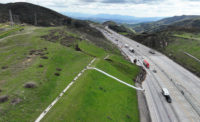National Park Service officials say flood-damaged sections of Yellowstone National Park’s northern loop road could reopen in early July, thanks to $60 million in federal emergency funding that will help expedite the start of a long and potentially expensive recovery from what the U.S. Geologic Survey estimates was a 500-year flood event earlier this month.
After initially expressing uncertainty about Yellowstone’s immediate future following the rain- and snowmelt-driven floods, NPS subsequently issued a more optimistic forecast for the remainder of the park’s prime tourist season, which typically peaks in July with nearly one million visitors. Along with reopening Yellowstone’s largely undamaged southern loop road on June 22, the agency said in a statement that the northern loop road was expected to reopen “in two weeks or less following completion of clean-up, repairs and final inspection” of the area’s infrastructure, restoring visitor access to approximately 80% of the park.
A priority for the $60 million in Federal Highway Administration “quick release” emergency funds will be establishing a temporary alternative to U.S. Route 89/North Entrance Road, which sustained severe damage from the adjacent high-flowing Gardiner River on both sides of the park boundary. Upgrading the parallel Old Gardiner Road between Gardner, Mont., and NPS offices in Mammoth Hot Springs “will ensure essential emergency services, food, supplies and other administrative needs will be available throughout the winter months,” NPS said.
FHWA also authorized road construction crews and materials that were already deployed in the park for a previously scheduled 22-mile road improvement project to be diverted to the Old Gardiner Road upgrade. The agencies are exploring opportunities to restore limited visitor access via the North Entrance, including temporary permanent road reconstruction options.
In addition, FHWA is providing a total of $5 million to transportation departments in Montana and Wyoming to help repair flood-damaged state-maintained roads and bridges outside Yellowstone.
While speculation regarding Yellowstone’s total infrastructure repair cost has ranged as high as $1 billion, NPS has yet to release a full assessment of flood-related damage. Published images indicated multiple areas of washed-out roads, footbridges and other infrastructure across the 3,472-sq-mile park’s northern section. Electric, water and wastewater systems in those areas were also disrupted, and continue to be monitored.
One particularly hard-hit section is Yellowstone’s Northeast Access Road, which remains impassible due to multiple mudslides and washouts. Although NPS and FHWA are exploring temporary and permanent restoration options, “cost, funding and timelines are not yet available,” NPS said. The Northeast Access Road includes the 60-year-old, 604-ft-long Yellowstone River Bridge, which was due to undergo a three-year replacement project beginning later this year. The status of that project has not been announced.
NPS officials have stated that repair and restoration strategies will have to consider a variety of factors on top of the park’s historic and highly sensitive environmental elements, including safeguarding new and restored infrastructure against the likely prospect of more frequent severe weather events and other impacts associated with climate change.



